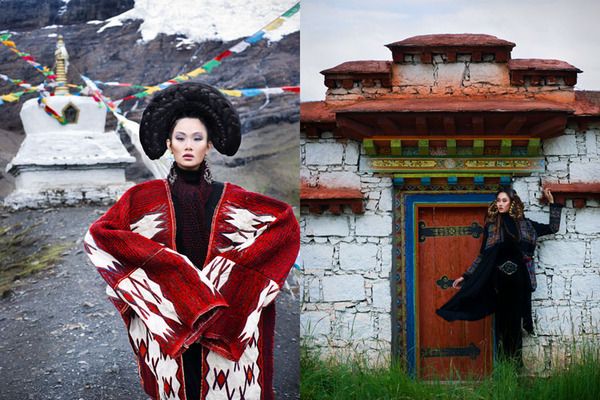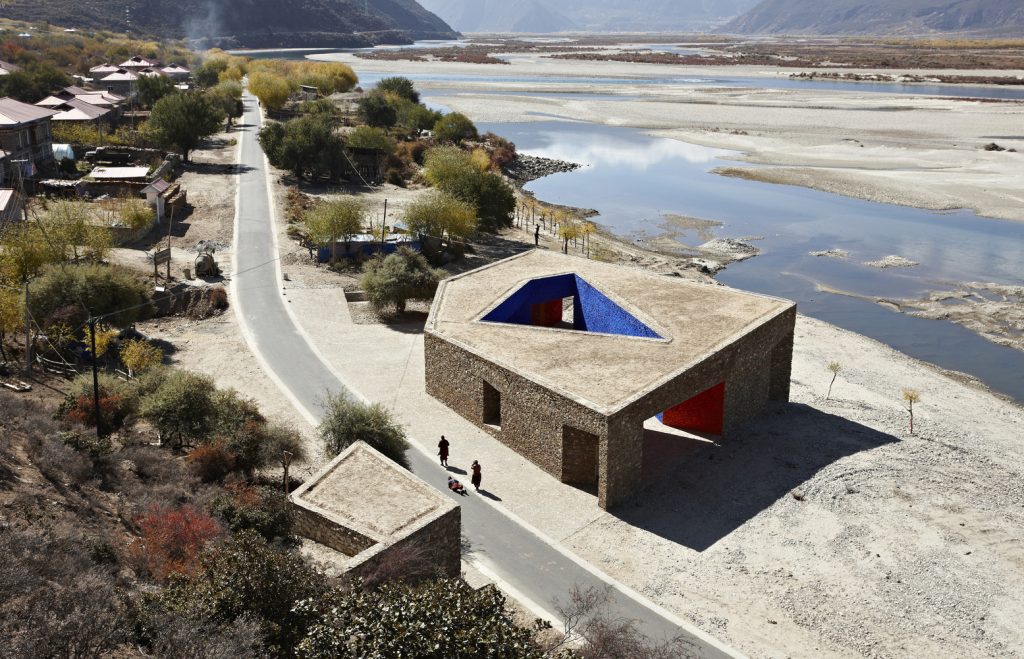“Design is a cultural statement. In Denmark and Finland it was always used to market the country but we’re still not quite there,” says Alfredo Häberli
Author Archives: camilla
inspired eclecticism
As the daughter of two antique dealers, Laura Gonzalez has made herself a name in the world of interiors with a penchant for classics mixed with the unexpected.
By Camilla Alfthan, photos Francis Amiand
parisian variations
An expat in Paris enters a world of history and heritage.
By Camilla Alfthan, Antik &Auktion, 2020
a bigger ball game
Beryl Lacoste continues the legacy of her grandfather as she extends her involvement in tennis.
By Camilla Alfthan, Hufvudstadsbladet, July 2019
world’s greatest skier
The day Mikaela Shiffrin captured her first Super G and joined the happy few of alpine skiing.
By Camilla Alfthan, Scandinavian Traveler, March 2019
treasure island
In the southern archipelago of Greenland, a Danish archeologist discovered the worlds oldest rubies.
By Camilla Alfthan, HBL, photos van Steinwijk,HBL, December 2019
northern reflections
In a turbulent world personal relations are more important than ever, says Denmark’s grand old man of foreign affairs, Uffe Ellemann-Jensen.
By Camilla Alfthan, Hufvudstadsbladet, May 2021
Tibet’s realistic optimist
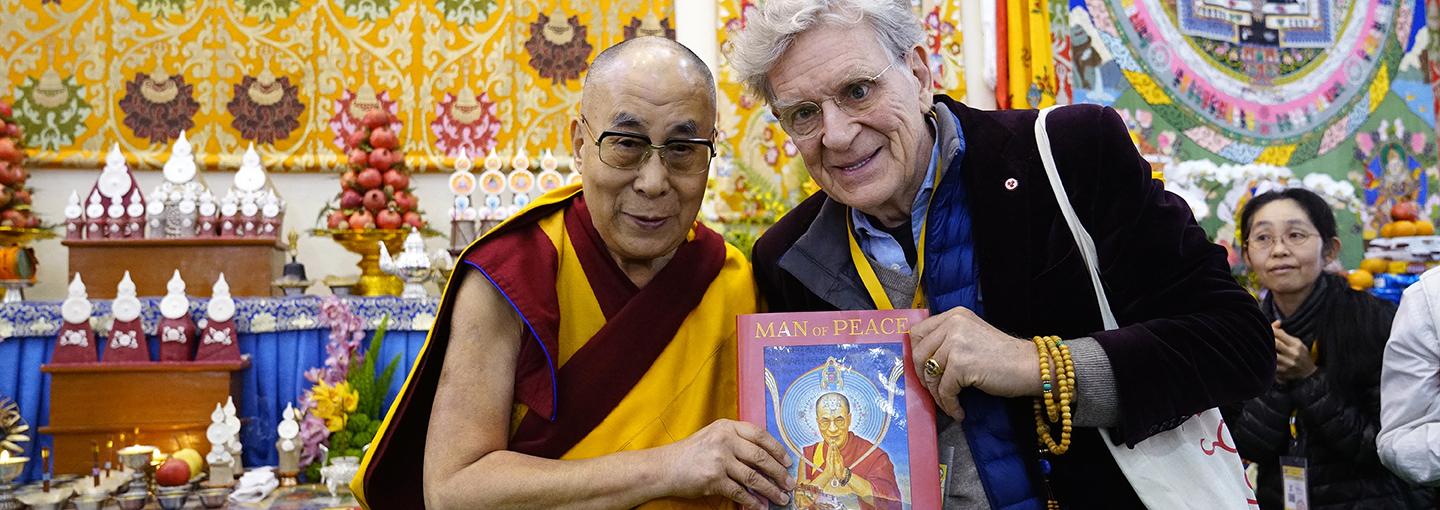 “Dalai Lama spreads happiness..If you think positively when you resist there’s a greater chance that you will succeed,” says Bob Thurman who calls himself “a realistic optimist in the current nightmare caused by leaders that are ignorant, greedy and stubborn”. Since the early sixties he’s been a close friend of the Dalai Lama. Last year he published the book ‘Man of Peace’ which introduces the Tibetan buddhism to the younger generations.
“Dalai Lama spreads happiness..If you think positively when you resist there’s a greater chance that you will succeed,” says Bob Thurman who calls himself “a realistic optimist in the current nightmare caused by leaders that are ignorant, greedy and stubborn”. Since the early sixties he’s been a close friend of the Dalai Lama. Last year he published the book ‘Man of Peace’ which introduces the Tibetan buddhism to the younger generations.
Despite Tibet’s many challenges, professor Robert Thurman takes the brighter view. China will gain from a good relation with the Dalai Lama. When that happens, Tibet will become the jewell of the Chinese empire.
By Camilla Alfthan
“THE TIBETANS are the baby seals of the human rights movement, they’re non violent and believe in word peace. But they’re still being crushed. The Dalai Lama told the Chinese a long time ago that even even though they were invaded in the 1950s they do not need independence if they’re allowed their own constitution and if they allow them to have a minority autonomy, they’d be happy to be a part of a Chinese union. But the Chinese are pretending the Tibetans want to separate to have an excuse to be hard liners,” tells Robert Thurman, founder of Tibet House in New York.
As a professor of religion at the Columbia University he has specialized in the Indian and Tibetan versions of buddhism. That religion and international politics are cut from the same cloth was a lesson that Thurman learned as a young Harvard freshman when he first met the Dalai Lama in his Indian exile. The iconic leader who is perceived to be the 14th reincarnation of his predecessor was only 19 when he negotiated his country’s future with China’s Mao Tse-tung. After several years of failed peace negotiations he fled to Dharmsala where he now functions as the Tibetans spiritual leader while he has handed over his political obligations to the Harvard educated professor, Lobsay Sangay.
Why is Tibet so important today? Tibet is very important because it is a colonial possession of China. And China is a big emerging power in the world trying to convince people that they’re not a threat and so good and great to do business with. They’re cracking down on Tibet along with the Uyghur people of Xian. How can they be believed when they are cracking down on their own people though Hong Kong, Vietnam, Philippines, South Chorea have relaxed their control of minorities? When China controls something they crush them; their culture, their freedom. If they say they have everything under control they’re completely crooked.
The Tibetans are second class citizens so Tibet is a symbol, though buddhism is different in Burma and Sri Lanka. Buddha is not threatening, it is not jihad. And yet they’re ruthlessly crushing them. So I think its an old fashioned policy of China. They’d like to change but haven’t decided how and they don’t want to make a mistake. In Scandinavia governments have learned that the Chinese are so insidiously trying to control the world media in the same way they control their own media, and have the own version of the press, and the history and future. They’ve realized that the Chinese won’t accept there’s free speech in so called democratic countries, and that they can’t suppress the people, so the do suppress them.
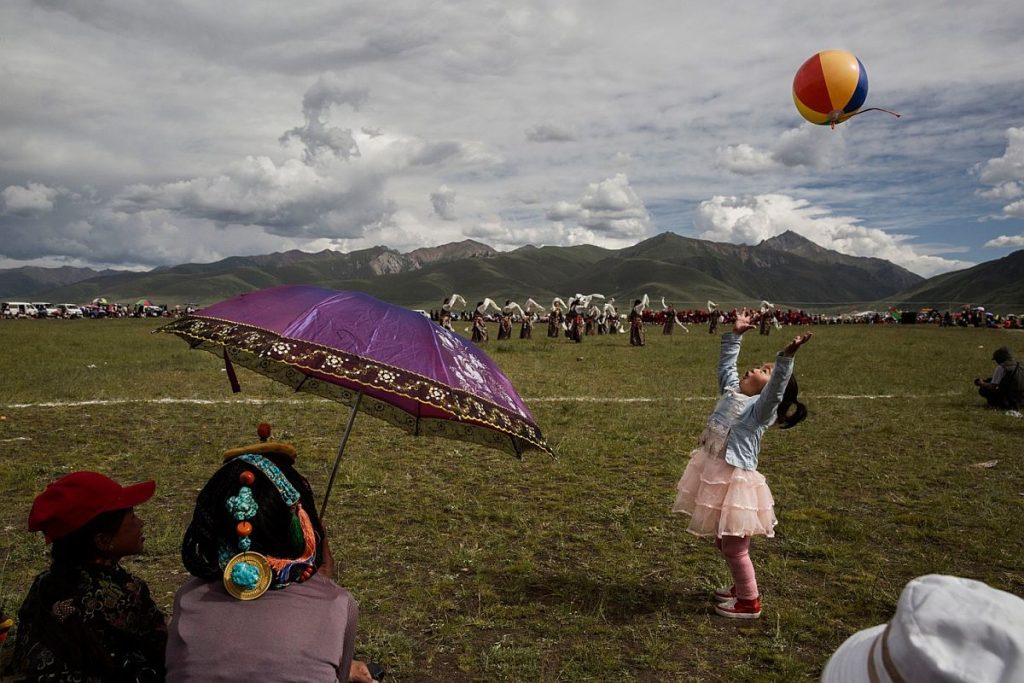 Girl playing on the Roof of the World – photo Kevin Frayer for the Washington Post.
Girl playing on the Roof of the World – photo Kevin Frayer for the Washington Post.
Will that change? I think I’m one of the rare people who think things will get better soon. Because China wants to function on the world stage, they will get public relations advice and probably think they’ll get a dictator’s advice on how to lie. But instead they’ll learn that the best way to show that you’re nice is to be nice. Especially when you can, and they certainly can with Tibet.
There’s a very foolish fraction now in the politbureau who are crushing the muslim people of Xiang. They have to retract the angry, jihadist type by creating such a a harsh suppression. Tibet is way down the list, and has been since the 2008 Olympics. They cracked down on them very harshly, but it paled in comparison to other countries.
The Uyghurs are in a terrible state. A million people in detention are being educated to be good people and communist Chinese citizens, instead of being muslim. It never works, they’re very resilient. I think the president Xi does recognize this, but you can’t change suddenly, they don’t want to make a mistake and continue the Chinese way for colonial centuries, not realising that they can make public relations out of a good relation with the Dalai Lama.
“Tibet would be a test page of how you can support people who are non-Chinese and not crack down and chew them up as citizens in a nation machine”
Tibet would be a test page of how you can support people who are non-Chinese, and not crack down and chew them up as citizens in a nation machine. This would put people at ease in places such as Hong Kong and Taiwan tremendously. I think he realises that, President Xi – I call him Emperor Xi at this point, almost. People don’t realise that even emperors don’t have absolute power and that it takes time to change policies.
When could it happen? I’m very optimistic that this will happen soon and within the lifetime of the Dalai Lama. He’ll be 84 next year and there will be many headlines, I think, when they make the conditions appropriate so that he could visit his people in his homeland. They have to persuade him that he can go to see his people, that he won’t go to prison. He can only go there when China says publicly that they will change their attitude about him and about the people and about buddhism. President Xi said they need ancient culture, that there’s a need to rehabilitate Confucius, and his family is interested in buddhism. I have no doubt there will be change, but when? That’s always the question.
The Tibetans survived the cultural revolution, and prior to that the Great War of the fifties when they quarantined hundreds of thousands and they turned everything upside down with their class struggle reforms and the gulag. They survived all that and they’re still Tibetans and they’ll survive anything else, so I’m optimistic about the future.
There’s a terrible trend on the planet now that our government here is mostly amending by the partnering with dictatorships, and this is an unfortunate thing. Therefore the Chinese and their Communist Imperium might be interested – because of the resources in Chinese culture – about what a responsible emperor is.
They were buddhists for 1,000 of years, Confucius made a very honorable thing about being emperor. Things will turn around, and even here in the US.
It’s important that people are aware of it, and familiar with it, because a human rights revolution is different than a communist revolution or any violent revolution – it’s a revolution that speaks against oppression. It’s very important that Tibet’s claims will succeed, as it will provide an example for many other minority issues; that violence is not the solution, but that actual dialogue and mutual support is the way forward.
There’s so much going on in the world of today. Are people less interested in Tibet? No, Tibet is going way back to Shangri-La, Wakanda, the magical roots of the world, Alexandre Davide Neil; the great French explorer in the 20th century. It goes way back. That’s why the Chinese are trying to keep the Dalai Lama from going anywhere because he is so photogenic; people like him so much. He fills stadiums even if he’s not trying to turn anyone into a buddhist, he just wants people to have a better life. He specifically does not want them to shift away from their religion. In polls, his popularity is right up there with Pope Francis. It’s died down a little in terms of activism, but it’s still very strong.
What has Tibet given you in your life? I love Tibet, it’s my intellectual home. The home of the scientific mind and psychology. I’d been looking to Freud, Wittgenstein and through that the original Indian enlightenment book about the Buddha. I was not a very religious, and I’m still not.
The allure was more of a scientific and cultural side. You really find many things that are very deep in the Indian philosophy and science, especially in mental science, how you change the mindset, and how you deal with it. That’s what I found there, after Harvard : Great psychology and modules about the rules of relativity, biology with a soul and a mind instead of this ridiculous idea that everything is just atoms and molecules; where we’re trapped in the West at the moment.
So, I have a gratitude to Tibet’s cultural and scientific gifts to me. The Dalai Lama was my friend since early sixties, the pre-hippie days. I worked to let people know about it. It was a cultural level for me, not so much a religious or a political level, so I’m very happy for that. I feel Tibetans are incredibly endurable and very strong.
“Tibet will become the jewell of China when they start caring about the Tibetans”
They resisted for over sixty years – reforms, class struggle and a kind of brainwashing they did really intensely. When there was a brief window in 1983-87, when China was trying to show nicer things, they started to rebuild their temples and their technical skills were amazing despite the fact that they’d been criminalizing this for thirty years. They just want to be Tibetans and have their culture.
Tibet will become the jewell of China when they start caring about the Tibetans. They made some stupid decisions when they moved Chinese people and factories there to develop the area. The Chinese took all the benefits and they wrecked the environment, they looted it. Destroyed the rivers and now they have a big water problem. You can’t bite of your nose – you only have one. They’ve realized this at the very top leadership level but the implementation is complex, they have to figure out how to do this in terms of logistics and the ministries that are involved.
Photos Nicoline Patricia Malina for Harper’s Bazaar.
But they will do it and then Tibet will be a jewell, like Switzerland, and they’ll make a lot of tourist money. In the eighties, they had quite a good tourist income there. Then they started their crushing business by the late eighties, and they lost the foreign tourists and got Chinese tourists. But that does not bring in money, it just circulates it. The point is; they’d make huge amounts in mountaineering, hiking, winter skiing, and the health industry – it could be a huge industry.
The Chinese are not really communists. The politbureau is the imperial committee. And now their president has a lifelong period -the envy of Mr Trump. They will continue with socialism. Confucianism was also that, where everyone had their little land of 9 acres and paid one ninth of taxes to the state.
There’s the religious cult, Dolgyan Shogden opposing the Dalai Lama.. Everyone has to counterforce everyone, but it doesn’t work. No-one is winning a single war anymore. The information is too widespread and the weapons are too powerful, so you can’t win wars any longer. The decolonisation of the 20th century was not out of the good will of Churchill, it had to do with the impossibility with the modern technology and economy of oppressing people. It doesn’t work. Some always survive and then they’ll get back after you, that’s the way it is. Now we’re forced into a new global society and hopefully there will be a law abiding nest. If anybody is a pioneer it is the Scandinavians. They are the ball, the middle way between…
What are your thoughts on the Chinese architect, Zhang Ke who won a prize for his buildings by the Niyang river? He looks like a great guy. He did a great job, and as an artists I’m sure he appreciates Tibetan architecture and culture, and he made a modern version of that.
A lot of Chinese love Tibet, actually, a lot of communist party members have the Dalai Lama in their little closet there, they do! And it’s just a matter of time before they kind of deal with it. Then they have to deal with the integration of the Chinese buddhism and Tibetan buddhism because they are different. The popularity of Tibets buddhism makes some of the Chinese teachers a little worried. There will be dialogue. It will all work out, I’m pretty sure.
I get lots of Chinese students at Columbia, many undergraduates. They’re dying to learn about buddhism, they particularily love Tibet, the young ones go hiking there, they have Tibetan boyfriends or girlfriends. They go riding there, they like the colourfulness of the culture and don’t want to see it marginalised. It will all work out…
The Dalai Lama once said at at dinner party to people who had helped Tibet, “Thank you very much. But I want you to know that in the long run, if you want to help Tibet, help everybody else, too”. So that’s the attitude.” ©
King for two months
After the declaration of Independence, Finland elected its first – and last – monarch. His great-grandson is a photographer in Germany.
By Camilla Alfthan
‘Väinö the First’ was the nickname of the prince who in 1918 became Finland’s first monarch – a name inspired by Väinamöinen; the hero of Finland’s epic Kalevala tales. His real name was a little longer – Charles the first, King of Finland and Karelia, count of Åland, Grand Duke of Lapland, Lord of Kalevala and the Nordics. An impressive row of titles for the man elected ruler of Great Finland.
The story, however, turned out differently and the monarchy was abandoned after just two months, before the new king had even set foot on Finnish soil. Though Finland’s short-lived flirt with monarchy is now a colourful interlude in the nation’s turbulent beginnings, the king is not entirely forgotten.
In Helsinki the House of Knights recently opened an exhibition about his two months on the throne. Guest of honour was the German prince Philipp of Hessen who today could have been king of Finland had his great-grandfather remained in this position.
The exhibition displayed the impressive speed with which the Finns began to create their own royal house. Letters of nobility were written and a crown was drawn, while the famous painter, Akseli-Gallén Kallela designed uniforms for the employees of the court.
The Imperial Palace which was built during Finland’s years as an independent Russian duchy, was going to be transformed into a royal castle after a thorough renovation following the devastations of the civil war where the red guards had used it as their headquarters.
An architect and an interior designer of the department store, Stockmann were hired to decorate the king’s private residence – an impressive villa in the Eira district by Gustaf Estlander which had been completed by the famous Finnish architect, Eliel Saarinen. They drew detailed plans and travelled to European cities to buy furniture, mirrors, lamps, silver wear and porcelain. Much was German biedermeier – the height of fashion at the time. Nordic touches were Finnish ryas and Gustavian cupboards.
“The election of the king was a strategic decision as the Finns wanted a monarch as a counterbalance to the Russian dictator. They first asked the German emperor if they could have one of his sons but he declined and suggested his brother-in-law, Friedrich Karl, who was a prince and Landgraff of Hessen, “ tells his 47-year old great-grandson, Philipp of Hessen.
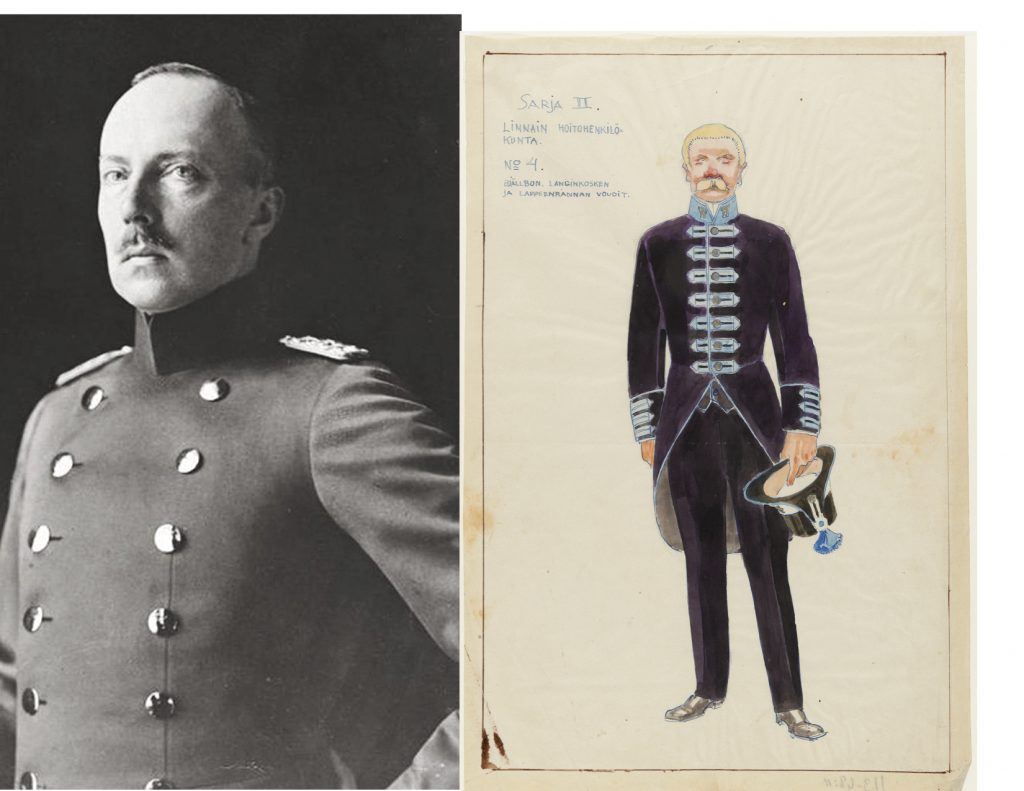 King Charles the First of Finland and his valet. Uniforms for his employees were designed by the famous painter, Akseli Gallén-Kallella. © Museiverket.
King Charles the First of Finland and his valet. Uniforms for his employees were designed by the famous painter, Akseli Gallén-Kallella. © Museiverket.
World War I was raging in most of Europe and a revolution had broken out in Russia. When Finland left the crumbling Czarist regime, the country was suddenly divided in two : The official White Finland which had declared its’ Independence and the Reds who wanted to join the new communist state. During the brief war which followed the Vasa government began to discuss a change in Finland’s constitution.
“The Russian revolution had spread to Finland and the bolsheviks encouraged the social democrats to take up arms. When the Soviets recognized Finland’s Independence on New Year’s eve 1917 it was only because they thought that the social democrats would take power,” tells historian Henrik Meinander.
The Germans became an important ally against the bolsheviks as Finnish soldiers who had been training in Germany – the chasseurs, who came back with their German brothers-in-arms to fight in the civil war. Only 11 days after their arrival at the coastline of Hangö they marched into the capital and declared victory even if the final battles did not end until one month later, on May 15th led by the legendary general Mannerheim.
»The alliance with the Germans helped secure Finland’s independence and the idea was that a monarchy would do the same even if the Finnish law did not quite allow such a change in the constitution. So they chose a form of government from 1772 when Finland was a part of the Swedish monarchy,” tells Meinander.
The Duke of Mecklenburg was among the candidates to the throne. Friedrich Karl of Hessen was a candidate and a sceptic, wishing that the entire Finnish population should support his candidacy. The Danish Prince Axel who was an admiral in the royal navy was also briefly mentioned. The German pressure was strong and the opposition had a hard time being heard, just as the advocates of a Swedish candidate.
“If they must have a king they can take the prince of Wied-Albania who is used to being removed and used to the idea that a bullet is already cast for him. They should understand that a bosch king in the year of 1918 won’t be long-lived,” a Finnish diplomat in Paris wrote ironically.
A Bosch king, a German, was nevertheless elected on October 9th when the Landgraff of Hessen was chosen with a small majority, despite the fact that the social democrats had long fled the country or been imprisoned.
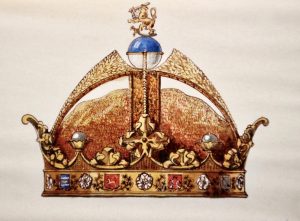
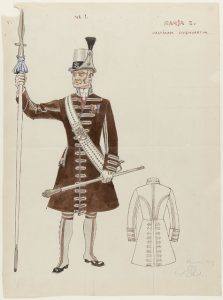
The crown as a sketch. A Finnish jewelry company later made a replica.
The timing, however, could not have been worse. Only a month after Friedrich Karl’s election Germany lost the war and their own imperial rule was abruptly put to an end. None of the Western victors had an interest in recognizing the German king and the course was subsequently changed. The king was no longer going to be invited to Finland, the government had to step down and politics should no longer be based on friendly turns.
On December 14th Friedrich Karl retired after just two months on the throne. General Mannerheim became head of the national assembly and the Finns chose their first president, the lawyer K.J. Ståhlberg. As a republic the country ended up with a modern, an entirely different identity, which was in line with the constitutional changes of 1906 when the nobility lost its power and women the following year could run for parliament as the first in the world.
“When the Norwegian monarchy was born in 1905 it happened under completely different and calmer circumstances, and with help from the Danes. In theory, a Finnish monarchy could have worked as a counterbalance to the revolution. The Russian empire had vanished but the Austrian, German and Osmanian monarchies were still the main governmental form, so the idea wasn’t completely wrong. It is only now that we can see things in a different light,” says Meinander.
When Finland celebrated the centennial of their independence, the king’s great-grandson was not invited “if I should try to take power,” jokes Philipp of Hessen who spent the day in Spain with his wife Laetitia and their three children.
The first time the prince was invited to the cold north by the people who could have been his Finnish subjects, he was 32 and a photographer assistant in New York. The newspaper, Helsingin Sanomat had invited him to the capital in a ‘what-if’ experiment as King Väinö. With photographers following his foot steps the king visited kindergartens, and met with cultural personalities and he was even photographed in front of the czar throne at the National Museum, which is the only existing throne outside of Russia.
“Today monarchy has changed. The royals are representatives for their countries and a continuation of their long histories. They are also fantastic for tourism – like a corporate identity!”
A few years ago prince Philipp moved from New York home to Hamburg where he works with his wife in her online company, Niche Beauté.
“ I grew up in Germany where there’s no longer a monarchy so I’m quite happy with the way things turned out. The Spanish royal house, the Dutch and the Danish – they are all good friends,” tells the prince who has just been to Denmark to visit Prince Joakim. The Greek king is also a relative.
“Somehow we’re all related,” laughs the prince who has photographed some of his blue blooded relatives for the American magazine, Vanity Fair.
The Finnish chapter is one of many flamboyant tales in his family, which includes Sweden’s King Fredrik who ruled in the 1700s and who was also Landgraff of Hessen.
Friedrich Karl’s wife, Princess Margaret of Prussia, a grandchild of England’s Queen Victoria, gave him six children. When the eldest two sons died in the First World War and the following heir to the throne did not have any children Philipp of Hessen would have been next in line.
“Instead he had a crazy life! From being a member of the Nazi party to becoming a prisoner of war and losing his wife in a concentration camp. I was ten when he died so I never got to ask him about his life,” tells the prince about his grandfather and namesake.
The gap between being a monarch and working with images is not as wide as one could think.
“Today monarchy has changed – it is completely different than in the old days. The royals are representatives for their countries and at the same time a continuation of their long histories. They are also fantastic for tourism – like a corporate identity. The Danes have made millions with Queen Margrethe,” tells Philipp of Hessen with a laugh.
When the Finnish monarchy was cancelled, the king’s treasures were sold at the department store, Stockmann. Some of the furniture was bought by the publishing tycoon, Amos Anderson. The would-have-been royal castle, became the presidential palace and the king’s grand villa was sold to Italy who still use the building as their embassy. In Kemi in Lapland where gold washers still find real, Finnish gold a jewelry company has made a copy of the crown which is exhibited as a curiosity. ©
“King for two months” is exhibited at the Museum Milavida in Tammerfors/Tampere from February 9th – October 28th. At the National Museum in Helsinki ‘The story about Finland’ shows the country’s transformation into an independent nation.
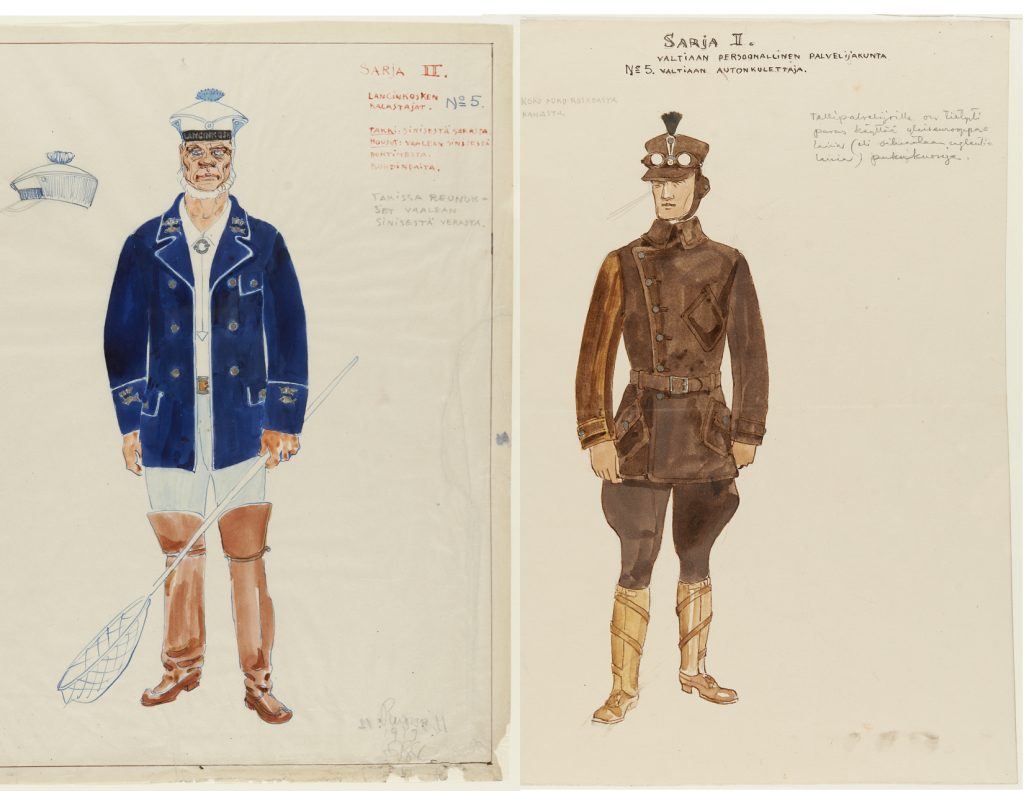
Uniforms for the employees at the court – a fisherman from the former Imperial fishing lodge at Langankoski, Eastern Finland and a driver. © Museiverket
tibet’s realistic optimist
Tibet will become the jewell of China when the Chinese start caring about the Tibetans, says professor Robert Thurman.
By Camilla Alfthan, Pov. Int’l
